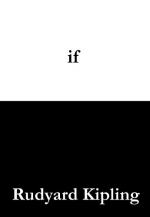|
This section contains 471 words (approx. 2 pages at 400 words per page) |

|
Iambic Pentameter and Rhyme
"If" is written in iambic pentameter, a form readers of Shakespeare will be familiar with, as the bard most often wrote in this style. Iambic pentameter consists of lines of five "feet" (two-syllable units) formed from an initial unstressed syllable and a second stressed syllable, as in the word "because." The eleven-syllable lines each end with an extra, unstressed syllable.
The poem is also written in four stanzas of eight rhyming lines, according to the pattern abab cdcd. "If" takes its name from the repetition of the word "if" at the start of the "a" and "c" lines, each of which comprise eleven syllables. The "b" and "d" lines each contain ten syllables.
Didacticism
The main aim of "If" is to instruct a young man in what Kipling considers the virtues of model leadership and exemplary manhood. To serve an instructive end, the poem has...
|
This section contains 471 words (approx. 2 pages at 400 words per page) |

|




